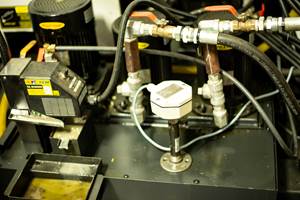Video: High Production Rate on VMCs Using Robotic Automation
This “Twin Cell” system uses one robot to deliver work into the cell and another robot to load both of the machines. The choice to remove machine doors enables faster load/unload time between machining cycles.
Share





The video details how vision and robotics enable two robots to keep production running rapidly through two small vertical machining centers. The robot inside the machines is gray because this is a corrosion-resistant robot suitable for use in an environment of flood coolant.
Methods Machine Tools has been supplying robotic automation with CNC machines for 17 years, but National Automation Manager John Lucier says that in just the last couple of years the conversation has changed. Rather than just considering automation, now customers frequently already have decided they want automation. As a result, he finds his team’s role consisting less of making the case for the robot and more in finding the right system to serve that particular application’s needs.
Yet the case for automation is still important to make. At a recent Methods open house event, Mr. Lucier co-presented a talk on robotic automation with Geoff Dawson, senior account manager with FANUC America. While about 4 percent of machine tools in general are sold with this automation, Mr. Dawson says, about 6 percent of machines supplied by Methods are sold this way.
Mr. Lucier says underestimation of lost time is perhaps the principal reason why good candidates for robotic machine tool automation still overlook this possibility. Most shops would be surprised to learn that their amount of in-cycle machining time as a share of available time is likely at best only 35 to 40 percent on standard machining centers, even in established and seemingly productive processes. Lost time on manually tended machines comes not just from the known interruptions such as lunch and coffee breaks, but also from inconsistent manual load and unload times, the likelihood of the operator not being immediately present at the very moment when a machining cycle completes, and even the natural but non-productive routines operators add to the task of loading a machine tool (such as spraying out the entire workzone between cycles or repeatedly striking the part with a mallet). The time for all of these steps and uncertainties add up to a significant amount of non-cutting time over the course of a shift. A machining system employing automated part load not only reduces this non-productive time, but also provides the chance to extend production into night or weekend hours that are not currently staffed.
The video above demonstrates an extreme alternative for minimizing the non-productive time. The system seen here uses two robots to load two vertical machining centers (VMCs). One robot loads randomly contained parts in a bin onto a conveyor that feeds into the workzone, and the other robot inside the workzone picks up parts to load the two different VMCs. This demo of Methods’ “Twin Cell” concept was running at the open house event.
The VMCs’ side doors facing the second robot were removed in the system seen here for the sake of cycle time, Mr. Lucier says. When the robot is ready with a new part in its gripper, it can reach almost all the way into the machine, hovering as if ready pounce in order to quickly swap out parts in the vise as soon as the machining cycle is done. However, there is a cost to this time savings, he notes. Removing the doors means the two machines and the robot between them all share the same environment—a single workzone, essentially. If the doors are left in place, requiring the robot to stand back behind the door and spend seconds more on each part loading, then the advantage this continued separation brings is that one machine can be serviced while the other keeps running. But running this way, with the two machines merged into a common system, unlocks the perhaps surprising level of productivity that can be achieved on standard VMCs.
Related Content
Investing in Automation, Five-Axis to Increase Production Capacity
To meet an increase in demand, this shop invested heavily in automation solutions and five-axis machines to ramp up its production capabilities.
Read MoreManaging Coolant with Skimmers, Refractometers and More
Bacteria-infected coolant harms machines and sickens machinists. Coolant management technologies like skimmers and automated systems counter this tendency.
Read MoreHow to Accelerate Robotic Deburring & Automated Material Removal
Pairing automation with air-driven motors that push cutting tool speeds up to 65,000 RPM with no duty cycle can dramatically improve throughput and improve finishing.
Read MoreFour-Axis Horizontal Machining Doubles Shop’s Productivity
Horizontal four-axis machining enabled McKenzie CNC to cut operations and cycle times for its high-mix, high-repeat work — more than doubling its throughput.
Read MoreRead Next
5 Rules of Thumb for Buying CNC Machine Tools
Use these tips to carefully plan your machine tool purchases and to avoid regretting your decision later.
Read MoreSetting Up the Building Blocks for a Digital Factory
Woodward Inc. spent over a year developing an API to connect machines to its digital factory. Caron Engineering’s MiConnect has cut most of this process while also granting the shop greater access to machine information.
Read MoreRegistration Now Open for the Precision Machining Technology Show (PMTS) 2025
The precision machining industry’s premier event returns to Cleveland, OH, April 1-3.
Read More






















.jpg;maxWidth=300;quality=90)







